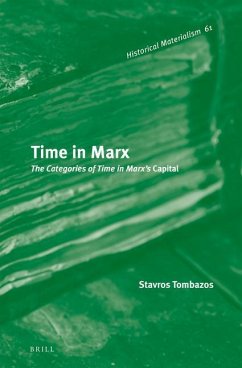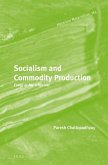- Gebundenes Buch
- Merkliste
- Auf die Merkliste
- Bewerten Bewerten
- Teilen
- Produkt teilen
- Produkterinnerung
- Produkterinnerung
By elucidating the inner consistency of the three volumes of Marx's Capital, this book poses the notion of capital as a specific form of organising social time, which itself functions as a thinking subject, relegating the individual to an inanimate object.
Andere Kunden interessierten sich auch für
![Marx for Our Times Marx for Our Times]() Daniel BensaidMarx for Our Times24,99 €
Daniel BensaidMarx for Our Times24,99 €![Invisible Leviathan Invisible Leviathan]() Murray SmithInvisible Leviathan233,99 €
Murray SmithInvisible Leviathan233,99 €![Marx and Social Justice Marx and Social Justice]() George E McCarthyMarx and Social Justice197,99 €
George E McCarthyMarx and Social Justice197,99 €![Beyond Marx Beyond Marx]() Beyond Marx276,99 €
Beyond Marx276,99 €![Socialism and Commodity Production: Essay in Marx Revival Socialism and Commodity Production: Essay in Marx Revival]() Paresh ChattopadhyaySocialism and Commodity Production: Essay in Marx Revival195,99 €
Paresh ChattopadhyaySocialism and Commodity Production: Essay in Marx Revival195,99 €![Immanent Externalities Immanent Externalities]() Rebecca CarsonImmanent Externalities162,99 €
Rebecca CarsonImmanent Externalities162,99 €![Beyond Liberal Egalitarianism Beyond Liberal Egalitarianism]() Tony SmithBeyond Liberal Egalitarianism185,99 €
Tony SmithBeyond Liberal Egalitarianism185,99 €-
-
-
By elucidating the inner consistency of the three volumes of Marx's Capital, this book poses the notion of capital as a specific form of organising social time, which itself functions as a thinking subject, relegating the individual to an inanimate object.
Hinweis: Dieser Artikel kann nur an eine deutsche Lieferadresse ausgeliefert werden.
Hinweis: Dieser Artikel kann nur an eine deutsche Lieferadresse ausgeliefert werden.
Produktdetails
- Produktdetails
- Verlag: Brill
- Seitenzahl: 354
- Erscheinungstermin: 25. November 2013
- Englisch
- Abmessung: 244mm x 164mm x 25mm
- Gewicht: 683g
- ISBN-13: 9789004217263
- ISBN-10: 9004217266
- Artikelnr.: 40049414
- Herstellerkennzeichnung
- Produktsicherheitsverantwortliche/r
- Europaallee 1
- 36244 Bad Hersfeld
- gpsr@libri.de
- Verlag: Brill
- Seitenzahl: 354
- Erscheinungstermin: 25. November 2013
- Englisch
- Abmessung: 244mm x 164mm x 25mm
- Gewicht: 683g
- ISBN-13: 9789004217263
- ISBN-10: 9004217266
- Artikelnr.: 40049414
- Herstellerkennzeichnung
- Produktsicherheitsverantwortliche/r
- Europaallee 1
- 36244 Bad Hersfeld
- gpsr@libri.de
Stavros Tombazos, Ph.D. (1991), Université Paris 8, is Assistant Professor of Political Economy at the University of Cyprus. He has published numerous books and articles on the thought of Hegel and Marx, on Globalisation, the European Integration and Capitalist Crises. His latest book, published in Greek, is titled: Centrifugal Times, The World Economic Crisis 2007, 2008, 2009... (Papazisis, 2010). He is a regular contributor to the French journals Contretemps and Lignes.
Introduction to the English Edition
The Missile's Load
Georges Labica
Rearguard Seasonals
Postface to the French edition by Daniel Bensaïd
Translator's Note
Introduction
PART I: THE TIME OF PRODUCTION
Introduction
Section 1: The Commodity and Labour Time
1.Labour Time as a Transhistorical Economic Law
2.Abstract Labour Time: Form and Content
3.Socially Necessary Labour Time
4.The Hegelian Theory of Measure and Value as 'Essence'
Section 2: From Simple Circulation to Capital
5.The Process of Exchange: Historical Time and Logical Time
5.1Historical time
5.2Logical time
6.Simple Circulation as a Moment of the Notion
6.1The great triad of Hegelian logic
6.2Simple circulation as a 'chemical process'
7.The Hidden Time of the Commodity
Section 3: The Time of the Process of Production
8.The Time of Surplus-Labour or Absolute Surplus-Value
8.1Constant and variable capital, mass and rate of surplus-value
8.2The working day
9.The Time of Surplus Labour or Relative Surplus-Value
9.1Simple co-operation and the saving of time
9.2 The manufacture and the saving of time
9.3 Large-scale industry as a clock-making system .
PART II: THE TIME OF CIRCULATION
Introduction.
Section 1: The Organic Movement of Capital
10.The Three Cycles/Circuits of Capital
10.1The circuit of money capital .
10.2The circuit of productive capital
10.3The circuit of commodity capital
11.Capital as Syllogism
12.Capital in Marx, or 'Life' in Hegel
12.1The Hegelian 'Idea' (generalities)
12.2Hegelian 'Life' and the circuits of capital
12.3'The living individual' or 'Shape' and the circuit of productive
capital
12.4The 'life process' or 'Assimilation' and the circuit of commodity
capital
12.5 The 'Genus-process' and the circuit of money capital
Section 2: The Turnover Times of Capital
13.Value, Real Wealth and Circulation Time
14.Turnover Time and Fixed and Circulating Capital
15.The Labour, Production and Circulation Periods
15.1Definition of the three periods
15.2The turnover time and the quantitative relation between the different
fractions of capital
16.The Annual Turnover of Social Capital (The Schemas of Reproduction)
16.1Presentation of the schemas of reproduction
16.2Interpretation of the schemas of reproduction
PART III: ORGANIC TIME: THE UNITY OF THE TIME OF PRODUCTION AND THE TIME OF
CIRCULATION
Introduction
Section 1: Surplus Value, Profit and Time
17.Cost, Wages, Profit and Illusions of Time
18.Value and Prices of Production (A Logical Interpretation)
18.1Marx and the transformation of values into prices of production
18.2The transformation as a syllogism
Section 2: The Sub-Divisions of Profit or Fetishism Completely Realised
19.The Derived Forms of Industrial Capital
19.1Merchant's capital (Handelskapital)
19.2Interest-bearing capital (Das zinstragende Kapital)
20.Ground Rent
21.The Trinity Formula
Section 3: The Contradictions of the Capitalist Organisation of Time
22.The Law of the Tendency of the Rate of Profit to Fall
23. The Periodical Crises
23.1Periodical crises and the industrial cycle
23.2The long-term tendency of the rate of profit
24. The Structural Crises
24.1 Appendix to Chapter 24
Conclusion
Bibliography
Index
The Missile's Load
Georges Labica
Rearguard Seasonals
Postface to the French edition by Daniel Bensaïd
Translator's Note
Introduction
PART I: THE TIME OF PRODUCTION
Introduction
Section 1: The Commodity and Labour Time
1.Labour Time as a Transhistorical Economic Law
2.Abstract Labour Time: Form and Content
3.Socially Necessary Labour Time
4.The Hegelian Theory of Measure and Value as 'Essence'
Section 2: From Simple Circulation to Capital
5.The Process of Exchange: Historical Time and Logical Time
5.1Historical time
5.2Logical time
6.Simple Circulation as a Moment of the Notion
6.1The great triad of Hegelian logic
6.2Simple circulation as a 'chemical process'
7.The Hidden Time of the Commodity
Section 3: The Time of the Process of Production
8.The Time of Surplus-Labour or Absolute Surplus-Value
8.1Constant and variable capital, mass and rate of surplus-value
8.2The working day
9.The Time of Surplus Labour or Relative Surplus-Value
9.1Simple co-operation and the saving of time
9.2 The manufacture and the saving of time
9.3 Large-scale industry as a clock-making system .
PART II: THE TIME OF CIRCULATION
Introduction.
Section 1: The Organic Movement of Capital
10.The Three Cycles/Circuits of Capital
10.1The circuit of money capital .
10.2The circuit of productive capital
10.3The circuit of commodity capital
11.Capital as Syllogism
12.Capital in Marx, or 'Life' in Hegel
12.1The Hegelian 'Idea' (generalities)
12.2Hegelian 'Life' and the circuits of capital
12.3'The living individual' or 'Shape' and the circuit of productive
capital
12.4The 'life process' or 'Assimilation' and the circuit of commodity
capital
12.5 The 'Genus-process' and the circuit of money capital
Section 2: The Turnover Times of Capital
13.Value, Real Wealth and Circulation Time
14.Turnover Time and Fixed and Circulating Capital
15.The Labour, Production and Circulation Periods
15.1Definition of the three periods
15.2The turnover time and the quantitative relation between the different
fractions of capital
16.The Annual Turnover of Social Capital (The Schemas of Reproduction)
16.1Presentation of the schemas of reproduction
16.2Interpretation of the schemas of reproduction
PART III: ORGANIC TIME: THE UNITY OF THE TIME OF PRODUCTION AND THE TIME OF
CIRCULATION
Introduction
Section 1: Surplus Value, Profit and Time
17.Cost, Wages, Profit and Illusions of Time
18.Value and Prices of Production (A Logical Interpretation)
18.1Marx and the transformation of values into prices of production
18.2The transformation as a syllogism
Section 2: The Sub-Divisions of Profit or Fetishism Completely Realised
19.The Derived Forms of Industrial Capital
19.1Merchant's capital (Handelskapital)
19.2Interest-bearing capital (Das zinstragende Kapital)
20.Ground Rent
21.The Trinity Formula
Section 3: The Contradictions of the Capitalist Organisation of Time
22.The Law of the Tendency of the Rate of Profit to Fall
23. The Periodical Crises
23.1Periodical crises and the industrial cycle
23.2The long-term tendency of the rate of profit
24. The Structural Crises
24.1 Appendix to Chapter 24
Conclusion
Bibliography
Index
Introduction to the English Edition
The Missile's Load
Georges Labica
Rearguard Seasonals
Postface to the French edition by Daniel Bensaïd
Translator's Note
Introduction
PART I: THE TIME OF PRODUCTION
Introduction
Section 1: The Commodity and Labour Time
1.Labour Time as a Transhistorical Economic Law
2.Abstract Labour Time: Form and Content
3.Socially Necessary Labour Time
4.The Hegelian Theory of Measure and Value as 'Essence'
Section 2: From Simple Circulation to Capital
5.The Process of Exchange: Historical Time and Logical Time
5.1Historical time
5.2Logical time
6.Simple Circulation as a Moment of the Notion
6.1The great triad of Hegelian logic
6.2Simple circulation as a 'chemical process'
7.The Hidden Time of the Commodity
Section 3: The Time of the Process of Production
8.The Time of Surplus-Labour or Absolute Surplus-Value
8.1Constant and variable capital, mass and rate of surplus-value
8.2The working day
9.The Time of Surplus Labour or Relative Surplus-Value
9.1Simple co-operation and the saving of time
9.2 The manufacture and the saving of time
9.3 Large-scale industry as a clock-making system .
PART II: THE TIME OF CIRCULATION
Introduction.
Section 1: The Organic Movement of Capital
10.The Three Cycles/Circuits of Capital
10.1The circuit of money capital .
10.2The circuit of productive capital
10.3The circuit of commodity capital
11.Capital as Syllogism
12.Capital in Marx, or 'Life' in Hegel
12.1The Hegelian 'Idea' (generalities)
12.2Hegelian 'Life' and the circuits of capital
12.3'The living individual' or 'Shape' and the circuit of productive
capital
12.4The 'life process' or 'Assimilation' and the circuit of commodity
capital
12.5 The 'Genus-process' and the circuit of money capital
Section 2: The Turnover Times of Capital
13.Value, Real Wealth and Circulation Time
14.Turnover Time and Fixed and Circulating Capital
15.The Labour, Production and Circulation Periods
15.1Definition of the three periods
15.2The turnover time and the quantitative relation between the different
fractions of capital
16.The Annual Turnover of Social Capital (The Schemas of Reproduction)
16.1Presentation of the schemas of reproduction
16.2Interpretation of the schemas of reproduction
PART III: ORGANIC TIME: THE UNITY OF THE TIME OF PRODUCTION AND THE TIME OF
CIRCULATION
Introduction
Section 1: Surplus Value, Profit and Time
17.Cost, Wages, Profit and Illusions of Time
18.Value and Prices of Production (A Logical Interpretation)
18.1Marx and the transformation of values into prices of production
18.2The transformation as a syllogism
Section 2: The Sub-Divisions of Profit or Fetishism Completely Realised
19.The Derived Forms of Industrial Capital
19.1Merchant's capital (Handelskapital)
19.2Interest-bearing capital (Das zinstragende Kapital)
20.Ground Rent
21.The Trinity Formula
Section 3: The Contradictions of the Capitalist Organisation of Time
22.The Law of the Tendency of the Rate of Profit to Fall
23. The Periodical Crises
23.1Periodical crises and the industrial cycle
23.2The long-term tendency of the rate of profit
24. The Structural Crises
24.1 Appendix to Chapter 24
Conclusion
Bibliography
Index
The Missile's Load
Georges Labica
Rearguard Seasonals
Postface to the French edition by Daniel Bensaïd
Translator's Note
Introduction
PART I: THE TIME OF PRODUCTION
Introduction
Section 1: The Commodity and Labour Time
1.Labour Time as a Transhistorical Economic Law
2.Abstract Labour Time: Form and Content
3.Socially Necessary Labour Time
4.The Hegelian Theory of Measure and Value as 'Essence'
Section 2: From Simple Circulation to Capital
5.The Process of Exchange: Historical Time and Logical Time
5.1Historical time
5.2Logical time
6.Simple Circulation as a Moment of the Notion
6.1The great triad of Hegelian logic
6.2Simple circulation as a 'chemical process'
7.The Hidden Time of the Commodity
Section 3: The Time of the Process of Production
8.The Time of Surplus-Labour or Absolute Surplus-Value
8.1Constant and variable capital, mass and rate of surplus-value
8.2The working day
9.The Time of Surplus Labour or Relative Surplus-Value
9.1Simple co-operation and the saving of time
9.2 The manufacture and the saving of time
9.3 Large-scale industry as a clock-making system .
PART II: THE TIME OF CIRCULATION
Introduction.
Section 1: The Organic Movement of Capital
10.The Three Cycles/Circuits of Capital
10.1The circuit of money capital .
10.2The circuit of productive capital
10.3The circuit of commodity capital
11.Capital as Syllogism
12.Capital in Marx, or 'Life' in Hegel
12.1The Hegelian 'Idea' (generalities)
12.2Hegelian 'Life' and the circuits of capital
12.3'The living individual' or 'Shape' and the circuit of productive
capital
12.4The 'life process' or 'Assimilation' and the circuit of commodity
capital
12.5 The 'Genus-process' and the circuit of money capital
Section 2: The Turnover Times of Capital
13.Value, Real Wealth and Circulation Time
14.Turnover Time and Fixed and Circulating Capital
15.The Labour, Production and Circulation Periods
15.1Definition of the three periods
15.2The turnover time and the quantitative relation between the different
fractions of capital
16.The Annual Turnover of Social Capital (The Schemas of Reproduction)
16.1Presentation of the schemas of reproduction
16.2Interpretation of the schemas of reproduction
PART III: ORGANIC TIME: THE UNITY OF THE TIME OF PRODUCTION AND THE TIME OF
CIRCULATION
Introduction
Section 1: Surplus Value, Profit and Time
17.Cost, Wages, Profit and Illusions of Time
18.Value and Prices of Production (A Logical Interpretation)
18.1Marx and the transformation of values into prices of production
18.2The transformation as a syllogism
Section 2: The Sub-Divisions of Profit or Fetishism Completely Realised
19.The Derived Forms of Industrial Capital
19.1Merchant's capital (Handelskapital)
19.2Interest-bearing capital (Das zinstragende Kapital)
20.Ground Rent
21.The Trinity Formula
Section 3: The Contradictions of the Capitalist Organisation of Time
22.The Law of the Tendency of the Rate of Profit to Fall
23. The Periodical Crises
23.1Periodical crises and the industrial cycle
23.2The long-term tendency of the rate of profit
24. The Structural Crises
24.1 Appendix to Chapter 24
Conclusion
Bibliography
Index








